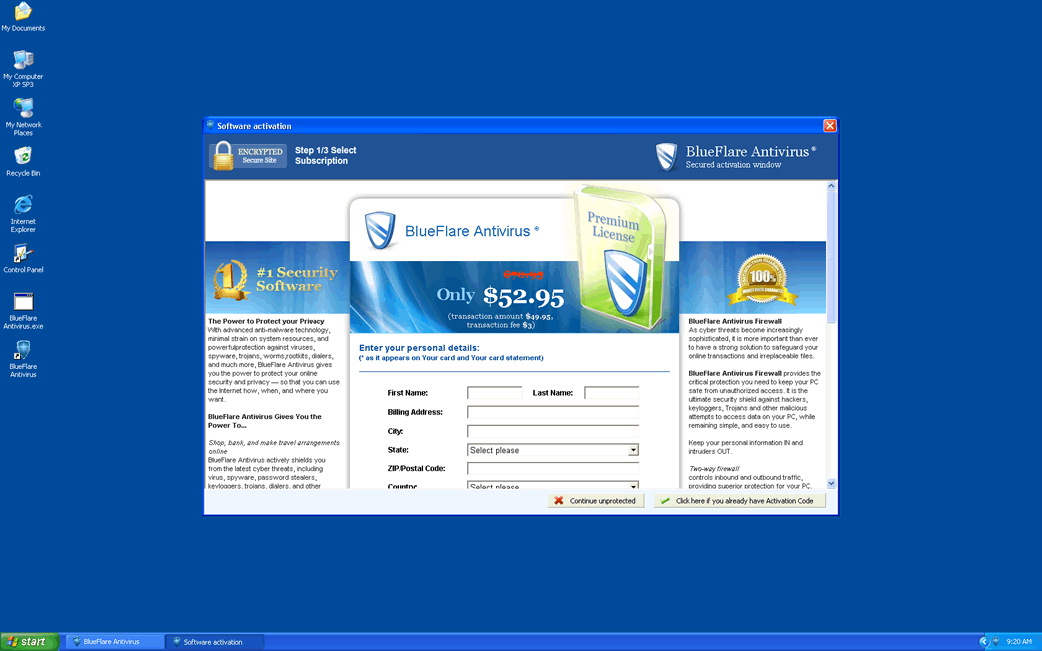BlueFlare Antivirus
Threat Scorecard
EnigmaSoft Threat Scorecard
EnigmaSoft Threat Scorecards are assessment reports for different malware threats which have been collected and analyzed by our research team. EnigmaSoft Threat Scorecards evaluate and rank threats using several metrics including real-world and potential risk factors, trends, frequency, prevalence, and persistence. EnigmaSoft Threat Scorecards are updated regularly based on our research data and metrics and are useful for a wide range of computer users, from end users seeking solutions to remove malware from their systems to security experts analyzing threats.
EnigmaSoft Threat Scorecards display a variety of useful information, including:
Ranking: The ranking of a particular threat in EnigmaSoft’s Threat Database.
Severity Level: The determined severity level of an object, represented numerically, based on our risk modeling process and research, as explained in our Threat Assessment Criteria.
Infected Computers: The number of confirmed and suspected cases of a particular threat detected on infected computers as reported by SpyHunter.
See also Threat Assessment Criteria.
| Threat Level: | 100 % (High) |
| Infected Computers: | 12 |
| First Seen: | July 25, 2011 |
| Last Seen: | August 17, 2022 |
| OS(es) Affected: | Windows |

BlueFlare Antivirus Image
BlueFlare Antivirus (also appearing as Blue Flare Antivirus and BlueFlareAntivirus) is a typical rogue anti-virus program. Like most rogue security programs, BlueFlare Antivirus will pester you with fake security alerts and pop-up notifications, show you a system scan designed to make you panic, and affect your ability to access your own programs and the Internet. BlueFlare Antivirus usually enters a computer without the computer user's knowledge and, once installed, BlueFlare Antivirus will try to force the computer user to buy BlueFlare Antivirus by constant repetition. BlueFlare Antivirus is closely related to the Ppn.exe family of rogue security programs, including XP Security 2012, Win 7 Security 2012, Vista Security 2012, XP Total Security, Win 7 Total Security, Vista Total Security, and many others. ESG security researchers recommend that you remove BlueFlare Antivirus automatically with a legitimate anti-malware program.
Table of Contents
Early Detection of the BlueFlare Antivirus Threat
ESG malware researchers have found that BlueFlare Antivirus can attack a computer through malicious scripts while browsing the Internet. These usually use vulnerabilities in JavaScript or Flash to install BlueFlare Antivirus. If you visit high-risk websites regularly, disabling JavaScript or Flash may help stop BlueFlare Antivirus in its tracks. You should also be careful with websites that are generally thought to be safe. BlueFlare Antivirus may also gain access to your computer through poorly regulated advertisements. Advertisements that try to convince you to try out a free online malware scan, or try to sell you anti-virus software, are especially dangerous.
The BlueFlare Antivirus Fake System Scan
Once installed, the first thing BlueFlare Antivirus will try to do is to convince you that your computer is infected with a large number of viruses. You should keep in mind that all of BlueFlare Antivirus' security alerts and system scans are fake, designed to convince you to buy this useless rogue anti-virus program. In reality, the infections detected by BlueFlare Antivirus are completely nonexistent. The real problem on your PC is BlueFlare Antivirus itself.
Severe Problems Caused by BlueFlare Antivirus
Make no mistake about it, BlueFlare Antivirus is not limited to displaying fake security alerts and annoying error messages. ESG PC security researchers classify BlueFlare Antivirus as a dangerous threat, which can place your computer at risk. BlueFlare Antivirus has been known to change your Internet browser and system settings to make your computer vulnerable to further attacks. It will alter your browser to use a proxy server, which is then used to control your Internet browsing. It does this to redirect you aggressively to websites belonging to the creators of BlueFlare Antivirus, to push you into giving up and buying this useless program. To protect itself, BlueFlare Antivirus also blocks a very large number of programs and Windows Components that may be used to remove BlueFlare Antivirus. This can make BlueFlare Antivirus removal especially tough.
Aliases
7 security vendors flagged this file as malicious.
| Anti-Virus Software | Detection |
|---|---|
| Panda | Trj/CI.A |
| AVG | FakeAV.QHN |
| Ikarus | Trojan.Fakeav |
| Microsoft | Rogue:Win32/FakeScanti |
| BitDefender | Trojan.Generic.KDV.299386 |
| Avast | Win32:Malware-gen |
| McAfee | Artemis!B48CFFD6DD34 |
SpyHunter Detects & Remove BlueFlare Antivirus

File System Details
| # | File Name | MD5 |
Detections
Detections: The number of confirmed and suspected cases of a particular threat detected on
infected computers as reported by SpyHunter.
|
|---|---|---|---|
| 1. | BlueFlare Antivirus.exe | 4a93f2ee1468fbd3a3a19a79a746ffbe | 3 |
| 2. | csrss.exe | ff89cab4a86fb4615e41caf25e445887 | 1 |
| 3. | %CommonAppData%\[RANDOM CHARACTERS]\[RANDOM CHARACTERS].exe | ||
| 4. | %AppData%\BlueFlare Anti-Virus | ||
| 5. | %CommonAppData%\[RANDOM CHARACTERS] | ||
| 6. | %AppData%\BlueFlare Anti-Virus\cookies.sqlite | ||
| 7. | %Documents and Settings%\[UserName]\Application Data\BlueFlare Antivirus\[RANDOM CHARACTERS] | ||
| 8. | %AppData%\BlueFlare Anti-Virus\Instructions.ini | ||
| 9. | sbr32.dll | b48cffd6dd34e2fdd694093d57ecffd3 | 0 |
Registry Details
Directories
BlueFlare Antivirus may create the following directory or directories:
| %AppData%\BlueFlare Antivirus |


Submit Comment
Please DO NOT use this comment system for support or billing questions. For SpyHunter technical support requests, please contact our technical support team directly by opening a customer support ticket via your SpyHunter. For billing issues, please refer to our "Billing Questions or Problems?" page. For general inquiries (complaints, legal, press, marketing, copyright), visit our "Inquiries and Feedback" page.